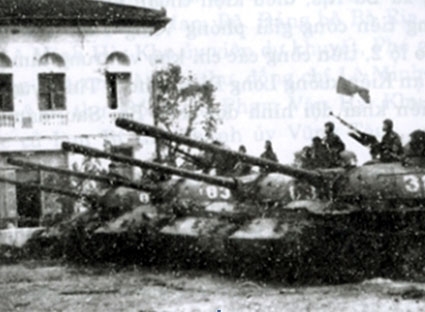From this direction, the liberation force at times had to use anti-aircraft guns as direct fire to support infantry troops in advancing. Failing to withstand the powerful offensive of the liberation force, the enemy troops had to flee Trang Bom and set up strongholds in Ho Nai.
At 8:30a.m. the same day, Division 341 took control of Trang Bom, causing heavy losses to two regiments of the 18th Division of the enemy. They neutralized 2,000 enemy troops and captured and destroyed nearly 100 mechanized vehicles, half of which were tanks and armored vehicles. All this allowed Division 341 to take control of 14km of Road 1.
Meanwhile, Division 6, attached with Regiment 209 of Division 7, one tank battalion, and two anti-aircraft battalions advanced along Road 1 and crushed strongholds of the enemy in Ong Hoang and disintegrated the 5th Armored Regiment of the enemy in Yen The. However, when the division moved to Long Lac - Ho Nai, the enemy troops gathered there and counter-attacked fiercely. In its offensive direction, Division 7, attached with Infantry Brigade 52, two tank companies and 50 mechanized vehicles, was organized into two contingents to carry out the missions.
From the Southeast, Army Corps 2 liberated Ba Ria town, took control of Van Kiep Training Center, and assisted locals in uprising and taking over the power. Division 3 then attacked Vung Tau. The enemy focused forces densely on the East side of Co May bridge, which had been torn down to prevent the liberation troops from advancing. Division 3 had to use local boats to cross the river from the far flank, forcing the enemy troops to withdraw from Co May bridge. Supported by local troops, the liberation troops liberated Binh Ba, Hoa Long, Long Phuoc, and Phu Nhon. At 5p.m. on April 27, Long Hai and Ba Ria were completely under the control of the liberation troops.
    |
 |
|
Tanks of the liberation force (File photo) |
In its major offensive direction, after nearly a day and a night of combat, Army Corps 2 destroyed three battalions of the enemy, arrested 500 prisoners of war, and completely controlled Long Thanh military sub-district. Thai Lac, Phuoc Rieng, and Phu Loi were liberated while Long Tan was besieged. Then the liberation troops attacked Nhon Trach with the aim to use Nhon Trach as leverage for the force to attack Tan Son Nhat. The enemy fought back fiercely, preventing the liberation force from capturing the target as planned.
From the Northwest, Division 316 of Army Corps 3 continued with the siege of Trang Bang, fighting back the counter-attacks of the enemy.
Army Corps 1 advanced from the North by shelling the outer defensive line of the enemy, including the strongholds of Phu Giao, Tan Uyen, Lai Thieu, Lai Khe, and Thu Dau Mot. With the support of a creeping barrage, Division 312 opened fire on Binh Co and Binh My strongholds along Road 16. After more than one hour of combat, Road 16 was cleared, creating conditions for the liberation troops to envelop Phu Loi base and seize the T-junction on Road 13 and Road 2 North of Binh Duong town. In this direction, on April 27, the liberation troops besieged, separated, and isolated the 5th Division of the Saigon military.
At night the same day, Division 320B of Army Corps and attached units attacked Ong Linh airport to open the path to Road 16. The enemy made use of the fortified trenches and bunkers to fight back fiercely, preventing the liberation troops from advancing.
In the West and Southwest directions, on April 27, Infantry Division 3 of Corps 232 captured An Ninh and Loc Giang, then crossed the Vam Co Dong River.
Translated by Huu Duong